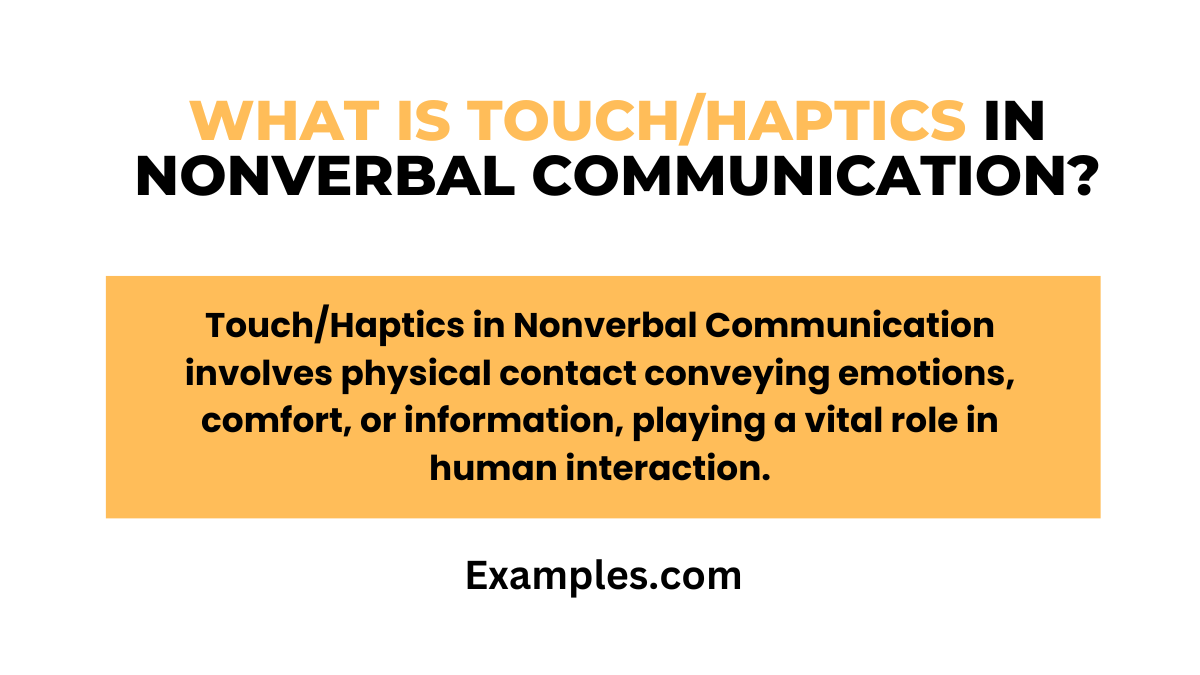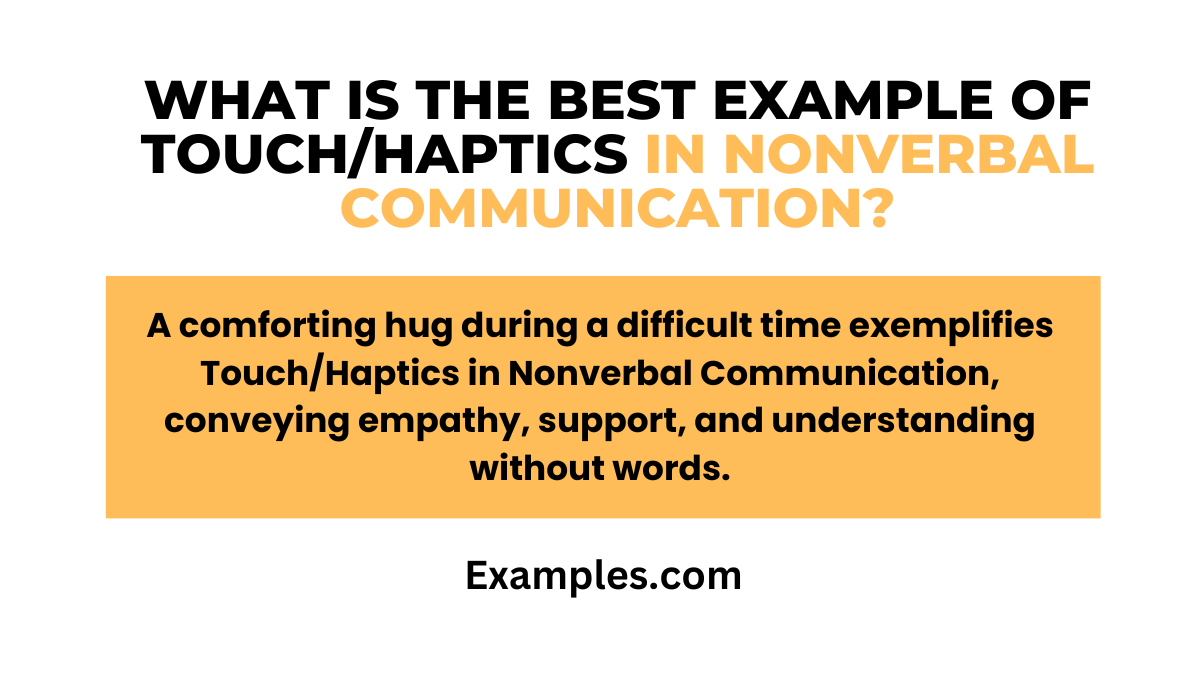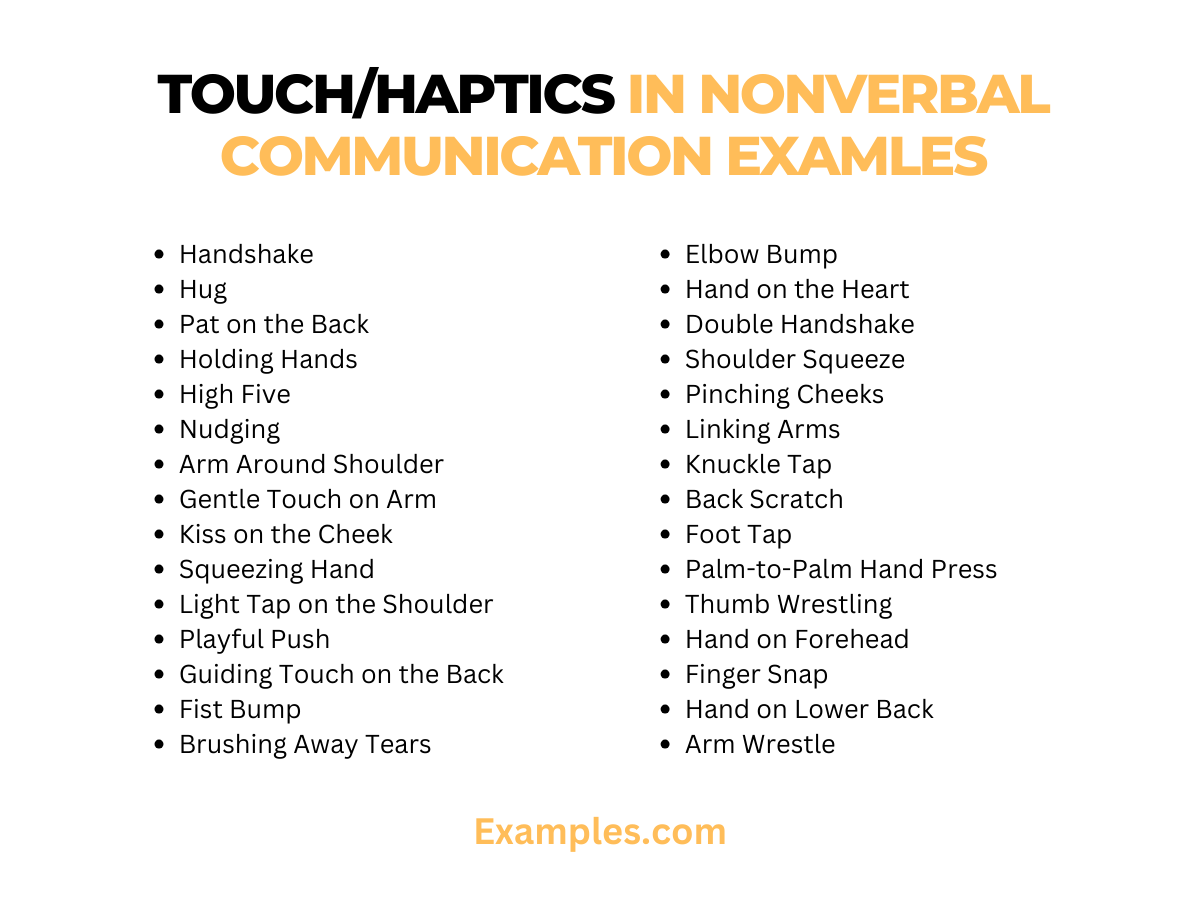29+ Touch/Haptics in Nonverbal Communication Examples
In the intricate dance of human interaction, Touch/Haptics in Nonverbal Communication plays a pivotal role. This comprehensive guide delves into various communication examples, showcasing how subtle touches can convey a spectrum of emotions and intentions. From a reassuring pat on the back to a gentle nudge, each gesture carries its unique message, transcending the barriers of spoken language. Explore the nuances of touch and learn to harness its power for more profound, empathetic connections.
What is Touch/Haptics in Nonverbal Communication?

Touch or haptics in nonverbal communication refers to the use of physical contact to convey messages. This subtle yet powerful form of communication extends beyond mere words, employing the sense of touch to express emotions, indicate support, or establish connections. From a firm handshake to a comforting hug, each gesture embodies a unique language, unspoken yet deeply felt.
What is the Best Example of Touch/Haptics in Nonverbal Communication?

A quintessential example of touch in nonverbal communication is the comforting embrace during times of distress. This simple act transcends cultural and linguistic boundaries, providing solace and expressing empathy without the need for words. It showcases the profound impact of nonverbal communication, where a gentle hug can convey support and understanding, forging a silent yet powerful bond between individuals.
30 Examples of Touch/Haptics in Nonverbal Communication

Explore the intricate world of Touch/Haptics in Nonverbal Communication with our comprehensive guide. This article delves into 30 unique and distinct examples, each elucidated with brief explanations and practical sentences. Understanding how touch plays a vital role in conveying unspoken messages enhances interpersonal interactions. From gentle handshakes to reassuring pats, these examples underscore the importance and versatility of touch as a form of nonverbal communication.
1. Handshake
Bold Example: A firm handshake at a business meeting.
Explanation: Conveys professionalism and confidence.
Example Sentence: “As I shook her hand firmly, it established a tone of mutual respect and professionalism.”
2. Hug
Bold Example: Embracing a friend at the airport.
Explanation: Signifies affection and joy.
Example Sentence: “The warm hug at the airport spoke volumes of our missed friendship.”
3. Pat on the Back
Bold Example: Patting a colleague on the back after a presentation.
Explanation: Indicates approval and support.
Example Sentence: “His pat on my back was a silent congratulation for my successful presentation.”
4. Holding Hands
Bold Example: Couples holding hands while walking.
Explanation: Shows intimacy and connection.
Example Sentence: “Holding hands while walking through the park, we felt a strong sense of closeness.”
5. High Five
Bold Example: Giving a high five after a successful team task.
Explanation: Represents teamwork and success.
Example Sentence: “We high-fived each other, celebrating our team’s achievement.”
6. Nudging
Bold Example: Nudging a friend during a joke.
Explanation: Suggests playfulness or shared humor.
Example Sentence: “I nudged her lightly as we laughed at the joke, sharing a moment of humor.”
7. Arm Around Shoulder
Bold Example: Placing an arm around a friend’s shoulder in comfort.
Explanation: Shows empathy and support.
Example Sentence: “I put my arm around her shoulder, offering comfort in her time of need.”
8. Gentle Touch on Arm
Bold Example: Touching someone’s arm during a conversation.
Explanation: Indicates attention or reassurance.
Example Sentence: “As he spoke, I touched his arm gently, showing my full attention and support.”
9. Kiss on the Cheek
Bold Example: A kiss on the cheek in greeting.
Explanation: Denotes friendship or cultural greeting.
Example Sentence: “Greeting her with a kiss on the cheek, we embraced our cultural tradition.”
10. Squeezing Hand
Bold Example: Squeezing a friend’s hand during a difficult moment.
Explanation: Conveys solidarity and comfort.
Example Sentence: “During her speech, I squeezed her hand, silently supporting her.”
11. Light Tap on the Shoulder
Bold Example: Tapping someone’s shoulder to get their attention.
Explanation: A polite way to signal your presence.
Example Sentence: “I tapped his shoulder gently to signal my arrival without startling him.”
12. Playful Push
Bold Example: Giving a playful push among friends.
Explanation: Indicates informality and fun.
Example Sentence: “Our playful pushes during the game reflected our close, easy-going friendship.”
13. Guiding Touch on the Back
Bold Example: Placing a hand on someone’s back to guide them.
Explanation: Shows direction and care.
Example Sentence: “I guided her through the crowd with a gentle touch on her back, ensuring she felt secure.”
14. Fist Bump
Bold Example: Exchanging a fist bump with a colleague.
Explanation: A casual gesture of agreement or celebration.
Example Sentence: “We fist bumped to silently celebrate our project’s approval.”
15. Brushing Away Tears
Bold Example: Brushing away someone’s tears.
Explanation: Represents comfort and empathy.
Example Sentence: “As I brushed away his tears, it was a moment of deep emotional connection.”
16. Elbow Bump
Bold Example: Greeting with an elbow bump in a social setting.
Explanation: A friendly and hygienic greeting alternative.
Example Sentence: “We exchanged elbow bumps, acknowledging each other in a socially responsible way.”
17. Hand on the Heart
Bold Example: Placing a hand over the heart.
Explanation: Signifies sincerity and emotion.
Example Sentence: “I placed my hand on my heart, showing my genuine gratitude and respect.”
18. Double Handshake
Bold Example: Gripping someone’s hand with both of yours.
Explanation: Expresses warmth and trust.
Example Sentence: “With a double handshake, I conveyed my deep respect and trust in him.”
19. Shoulder Squeeze
Bold Example: Squeezing a person’s shoulder lightly.
Explanation: Offers reassurance and encouragement.
Example Sentence: “Her shoulder squeeze was a comforting gesture, boosting my confidence.”
20. Pinching Cheeks
Bold Example: Lightly pinching a child’s cheek affectionately.
Explanation: A sign of affection, especially towards children.
Example Sentence: “The affectionate pinch on her cheek made the little girl giggle with delight.”
21. Linking Arms
Bold Example: Linking arms with a friend while walking.
Explanation: Shows camaraderie and support.
Example Sentence: “Linking arms, we walked with a sense of shared purpose and companionship.”
22. Knuckle Tap
Bold Example: Tapping knuckles against someone else’s.
Explanation: A gesture of acknowledgment or agreement.
Example Sentence: “Our quick knuckle tap was a silent agreement on the decision.”
23. Back Scratch
Bold Example: Scratching someone’s back as a favor.
Explanation: Indicates a casual, helpful gesture.
Example Sentence: “I scratched his back, helping him reach that impossible itch.”
24. Foot Tap
Bold Example: A playful foot tap under the table.
Explanation: Suggests a secret communication or playfulness.
Example Sentence: “Our discreet foot taps under the table became our secret way of communicating.”
25. Palm-to-Palm Hand Press
Bold Example: Pressing palms together in a greeting.
Explanation: Shows respect and equality.
Example Sentence: “We pressed palms together in a respectful greeting, honoring our mutual respect.”
26. Thumb Wrestling
Bold Example: Engaging in a friendly thumb wrestling match.
Explanation: A playful interaction signifying camaraderie.
Example Sentence: “Our thumb wrestling match was a light-hearted way to bond and share a laugh.”
27. Hand on Forehead
Bold Example: Placing a hand on someone’s forehead to check temperature.
Explanation: A caring gesture showing concern for health.
Example Sentence: “I placed my hand on his forehead, checking if he had a fever.”
28. Finger Snap
Bold Example: Snapping fingers to a rhythm.
Explanation: Indicates musical involvement or getting attention.
Example Sentence: “Snapping my fingers to the beat, I engaged everyone in the lively music.”
29. Hand on Lower Back
Bold Example: Guiding someone with a hand on their lower back.
Explanation: A guiding and protective gesture.
Example Sentence: “With my hand on her lower back, I guided her through the bustling room.”
30. Arm Wrestle
Bold Example: Engaging in an arm wrestling challenge.
Explanation: A playful display of strength and competitiveness.
Example Sentence: “Our friendly arm wrestle was less about winning and more about enjoying the challenge together.”
Why Touch / Haptics in Nonverbal Communication Important
Touch, or haptics, is a pivotal aspect of nonverbal communication, often overlooked in comparison to more visible forms like facial expressions or body language. However, the role of touch in conveying messages and emotions cannot be understated. This guide delves into the significance of touch in nonverbal communication, highlighting its unique role in interpersonal interactions.
The Power of Touch in Communication
Touch, as a form of nonverbal communication, goes beyond mere physical contact. It encompasses a range of interactions, from a reassuring pat on the back to a firm handshake. Each gesture carries a depth of meaning and can convey more than words ever could. In the realm of nonverbal communication examples, touch stands out for its ability to convey empathy, establish connections, and express emotions unspoken.
Emotional Connection and Empathy
Touch is a powerful tool for building emotional connections. A gentle touch can convey empathy and understanding, often more effectively than words. It has the unique ability to comfort and reassure, making it essential in contexts like healthcare or education, where empathy is crucial.
Conveying Messages and Intentions
In various scenarios, touch can communicate intentions and feelings more clearly than verbal communication. For example, a firm handshake can convey confidence and professionalism in a business setting. Similarly, a gentle touch on the arm can express concern or solidarity in a personal conversation.
Cultural and Contextual Significance
The meaning of touch varies significantly across cultures. In some cultures, touch is a common way to greet and show affection, while in others, it might be reserved for close relationships. Understanding these cultural nuances is crucial in nonverbal communication in different cultures.
Enhancing Verbal Communication
Touch often complements and enhances verbal communication. It can reinforce a spoken message, making it more impactful and memorable. For instance, a pat on the back along with words of encouragement can boost someone’s confidence more effectively than words alone.
Types of Touch in Nonverbal Communication
There are various types of touch, each serving different functions in communication. These include:
- Comforting Touch: Used to soothe and reassure.
- Affectionate Touch: Indicates love and fondness.
- Supportive Touch: Shows solidarity and support.
- Aggressive Touch: Communicates anger or dominance.
- Formal Touch: Seen in handshakes or formal greetings.
In conclusion, Touch/Haptics in Nonverbal Communication serves as a fundamental and intricate part of human interaction, facilitating a range of emotions and intentions beyond the capabilities of verbal communication. From the comforting hug that transcends cultural boundaries to the professional handshake that conveys confidence, touch is a multifaceted language that speaks volumes without uttering a single word. It plays a vital role in building emotional connections, expressing empathy, and enhancing verbal communication, making it an indispensable tool in both personal and professional settings????.
The variety of touches, each with its unique function and meaning, emphasizes the versatility and significance of this form of communication. Whether it’s a comforting touch that reassures, an affectionate touch that expresses love, or a formal touch used in professional greetings, understanding the nuances and appropriate use of touch is essential in effective communication. For those interested in exploring this topic further, resources like Psychology Today (https://www.psychologytoday.com offer insights into the psychological aspects of nonverbal communication. Additionally, educational institutions such as Harvard University (https://www.harvard.edu) provide extensive research and studies on the impact of nonverbal communication in different social and cultural contexts, making them valuable resources for deeper understanding and learning



